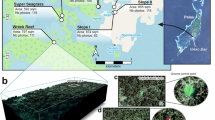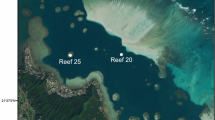Abstract
The present study aimed to examine the capabilities of a low-cost and standard drone (namely, the DJI™ Phantom 4 Pro) for mapping of coral reefs in shallow coastal waters. To this end, a coral site in Kish Island, located in the northern Persian Gulf, was selected as the study area, wherein other methods had been previously practiced to generate maps from the corals. The drone flight was operated by the Pix4Dcapture® mobile application, due to its simplicity and high capabilities for performing an automated flight based on user’s settings. The flight altitude was set at 50 m, covering the ~6 ha (200 × 300 m) area in ~5.5 min. Prior to the drone flight, 11 diving buoys were positioned as ground control points (GCPs) on the study area and their coordinates were subsequently measured three times via a handheld GPS. Afterwards, the Agisoft™ Metashape software was utilized to create the orthophoto mosaic from the total number of 121 overlapped taken photos. The spatial resolution of the final orthophoto mosaic was by ~2 cm, contributing to the identification of the features with the minimum size of 20 cm. Although the produced mosaic was geo-registered, it was geo-referenced once again based on the above-mentioned GCPs in the ENVI™ 5.3 software to increase planimetric accuracy. Thereafter, the corrected mosaic was digitized by on-screen digitizing in the Autodesk® AutoCAD Map software, so that an identifier (ID) was assigned to each polygon with reference to the types of corals or other substrate features such as the rocks. Consequently, a topological map was generated in the format of the ESRI™ shapefile. The results demonstrated that the proposed technique was capable to differentiate the types of corals (including bleached ones) and other substrate features. In comparison with other alternative methods, the given technique cost lower than field observations and its results were much more accurate compared with those from satellite imagery. The capabilities of the proposed technique may be significantly improved if drones equipped with a multispectral camera were used, but then again, the costs will be increasingly higher.






Similar content being viewed by others
References
Allen YC, Wilson CA, Roberts HH, Supan J (2005) High resolution mapping and classification of oyster habitats in nearshore Louisiana using sidescan sonar. Estuaries 28(3):435–446
Andréfouët S (2008) Coral reef habitat mapping using remote sensing: a user vs producer perspective. Implications for research, management and capacity building. J Spat Sci 53(1):113–129
Barry P, Coakley R (2013) Accuracy of UAV photogrammetry compared with network RTK GPS. Int Arch Photogramm Remote Sens 2:27–31
Casella E, Collin A, Harris D, Ferse S, Bejarano S, Parravicini V, Hench JL, Rovere A (2017) Mapping coral reefs using consumer-grade drones and structure from motion photogrammetry techniques. Coral Reefs 36(1):269–275
Collin A, Ramambason C, Pastol Y, Casella E, Rovere A, Thiault L et al (2018) Very high resolution mapping of coral reef state using airborne bathymetric LiDAR surface-intensity and drone imagery. Int J Remote Sens 39(17):5676–5688
Cuevas-Jiménez A, Ardisson PL, Condal AR (2002) Mapping of shallow coral reefs by colour aerial photography. Int J Remote Sens 23(18):3697–3712
Foster G, Walker BK, Riegl BM (2009) Interpretation of single-beam acoustic backscatter using lidar-derived topographic complexity and benthic habitat classifications in a coral reef environment. J Coast Res:16–26
Freiwald A, Wilson JB, Henrich R (1999) Grounding Pleistocene icebergs shape recent deep-water coral reefs. Sediment Geol 125(1–2):1–8
Greene LE, Alevizon WS (1989) Comparative accuracies of visual assessment methods for coral reef fishes. Bull Mar Sci 44(2):899–912
Holden H, LeDrew E (2002) Measuring and modeling water column effects on hyperspectral reflectance in a coral reef environment. Remote Sens Environ 81(2–3):300–308
Hume BC, D'Angelo C, Smith EG, Stevens JR, Burt J, Wiedenmann J (2015) Symbiodinium thermophilum sp. nov., a thermotolerant symbiotic alga prevalent in corals of the world's hottest sea, the Persian/Arabian Gulf. Sci Reps 5:8562
Intergovernmental Panel on Climate Change (2018) Global Warming of 1.5° C: An IPCC Special Report on the Impacts of Global Warming of 1.5° C Above Pre-industrial Levels and Related Global Greenhouse Gas Emission Pathways, in the Context of Strengthening the Global Response to the Threat of Climate Change, Sustainable Development, and Efforts to Eradicate Poverty. Intergovernmental Panel on Climate Change
Joyce KE, Duce S, Leahy SM, Leon J, Maier SW (2019) Principles and practice of acquiring drone-based image data in marine environments. Mar Freshw Res 70(7):952–963
Kabiri K, Pradhan B, Rezai H, Ghobadi Y, Moradi M (2012) Fluctuation of sea surface temperature in the Persian Gulf and its impact on coral reef communities around Kish Island. In: 2012 IEEE Colloquium on Humanities, Science and Engineering (CHUSER), IEEE, pp 164–167
Kabiri K, Pradhan B, Samimi-Namin K, Moradi M (2013a) Detecting coral bleaching, using QuickBird multi-temporal data: a feasibility study at Kish Island, the Persian Gulf. Estuar Coast Shelf Sci 117:273–281
Kabiri K, Pradhan B, Shafri HZM, Mansor SB, Samimi-Namin K (2013b) A novel approach to estimate diffuse attenuation coefficients for QuickBird satellite images: a case study at Kish Island, the Persian Gulf. J Indian Soc Remote Sens 41(4):797–806
Kabiri K, Rezai H, Moradi M, Pourjomeh F (2014) Coral reefs mapping using parasailing aerial photography-feasibility study: Kish Island, Persian Gulf. J Coast Conserv 18(6):691–699
Kabiri K, Rezai H, Moradi M (2018) Mapping of the corals around Hendorabi Island (Persian Gulf), using WorldView-2 standard imagery coupled with field observations. Mar Pollut Bull 129(1):266–274
Lewis J (2002) Evidence from aerial photography of structural loss of coral reefs at Barbados, West Indies. Coral Reefs 21(1):49–56
Lirman D, Gracias NR, Gintert BE, Gleason ACR, Reid RP, Negahdaripour S, Kramer P (2007) Development and application of a video-mosaic survey technology to document the status of coral reef communities. Environ Monit Assess 125(1–3):59–73
Manessa M, Kanno A, Sekine M, Ampou E, Widagti N, As-syakur A (2014) Shallow-water benthic identification using multispectral satellite imagery: investigation on the effects of improving noise correction method and spectral cover. Remote Sens 6(5):4454–4472
Mishra D, Narumalani S, Rundquist D, Lawson M (2006) Benthic habitat mapping in tropical marine environments using QuickBird multispectral data. Photogramm Eng Remote Sens 72(9):1037–1048
Mumby PJ, Green EP, Edwards AJ, Clark CD (1997) Coral reef habitat mapping: how much detail can remote sensing provide? Mar Biol 130(2):193–202
Palandro D, Andréfouët S, Dustan P, Muller-Karger FE (2003) Change detection in coral reef communities using Ikonos satellite sensor imagery and historic aerial photographs. Int J Remote Sens 24(4):873–878
Prada MC, Appeldoorn RS, Rivera JA (2008) The effects of minimum map unit in coral reefs maps generated from high resolution side scan sonar mosaics. Coral Reefs 27(2):297–310
Purkis SJ, Pasterkamp R (2004) Integrating in situ reef-top reflectance spectra with Landsat TM imagery to aid shallow-tropical benthic habitat mapping. Coral Reefs 23(1):5–20
Rezai H, Wilson S, Claereboudt M, Riegl B (2004) Coral reef status in the ROPME Sea area: Arabian/Persian Gulf, Gulf of Oman and Arabian Sea. Status of coral reefs of the world 1:155–170
Riegl B (1999) Corals in a non-reef setting in the southern Arabian gulf (Dubai, UAE): fauna and community structure in response to recurring mass mortality. Coral Reefs 18(1):63–73
Riegl BM, Purkis SJ (2005) Detection of shallow subtidal corals from IKONOS satellite and QTC view (50, 200 kHz) single-beam sonar data (Arabian gulf; Dubai, UAE). Remote Sens Environ 95(1):96–114
Rützler K (1978) Photogrammetry of reef environments by helium balloon. Coral Reefs: Research Methods: Monographs on oceanographic methodology
Scoffin TP (1982) Reef aerial photography from a kite. Coral Reefs 1(1):67–69
Seifert E, Seifert S, Vogt H, Drew D, van Aardt J, Kunneke A, Seifert T (2019) Influence of drone altitude, image overlap, and optical sensor resolution on multi-view reconstruction of Forest images. Remote Sens 11(10):1252
Sheppard CRC, Matheson K, Bythell JC, Murphy P, Myers CB, Blake B (1995) Habitat mapping in the Caribbean for management and conservation: use and assessment of aerial photography. Aquat Conserv Mar Freshwat Ecosyst 5(4):277–298
Singh H, Armstrong R, Gilbes F, Eustice R, Roman C, Pizarro O, Torres J (2004) Imaging coral I: imaging coral habitats with the SeaBED AUV. Subsurf Sens Technol Appl 5(1):25–42
Ventura D, Bruno M, Lasinio GJ, Belluscio A, Ardizzone G (2016) A low-cost drone based application for identifying and mapping of coastal fish nursery grounds. Estuar Coast Shelf Sci 171:85–98
Walker BK, Riegl B, Dodge RE (2008) Mapping coral reef habitats in Southeast Florida using a combined technique approach. J Coast Res:1138–1150
Yamano H, Tamura M (2004) Detection limits of coral reef bleaching by satellite remote sensing: simulation and data analysis. Remote Sens Environ 90(1):86–103
Zieger S, Stieglitz T, Kininmonth S, Buchroithner M (2008) Biotic classification of a coral reef using spatial pattern recognition from multibeam bathymetric sonar data. Remote Sens Environ 264:209–217
Acknowledgments
Authors thank Mr. Shirani and his colleagues in Kish Free Zone Organization (KFZO) for their contribution to the field observations in Kish Island. This research was supported by the Iranian National Science Foundation [grant no. INSF-98000990]; and Iranian National Institute for Oceanography and Atmospheric Science [grant no. INIOAS-397-023-01-012-01].
Author information
Authors and Affiliations
Corresponding author
Additional information
Communicated by: H. Babaie
Publisher’s note
Springer Nature remains neutral with regard to jurisdictional claims in published maps and institutional affiliations.
Rights and permissions
About this article
Cite this article
Kabiri, K., Rezai, H. & Moradi, M. A drone-based method for mapping the coral reefs in the shallow coastal waters – case study: Kish Island, Persian Gulf. Earth Sci Inform 13, 1265–1274 (2020). https://doi.org/10.1007/s12145-020-00507-z
Received:
Accepted:
Published:
Issue Date:
DOI: https://doi.org/10.1007/s12145-020-00507-z




